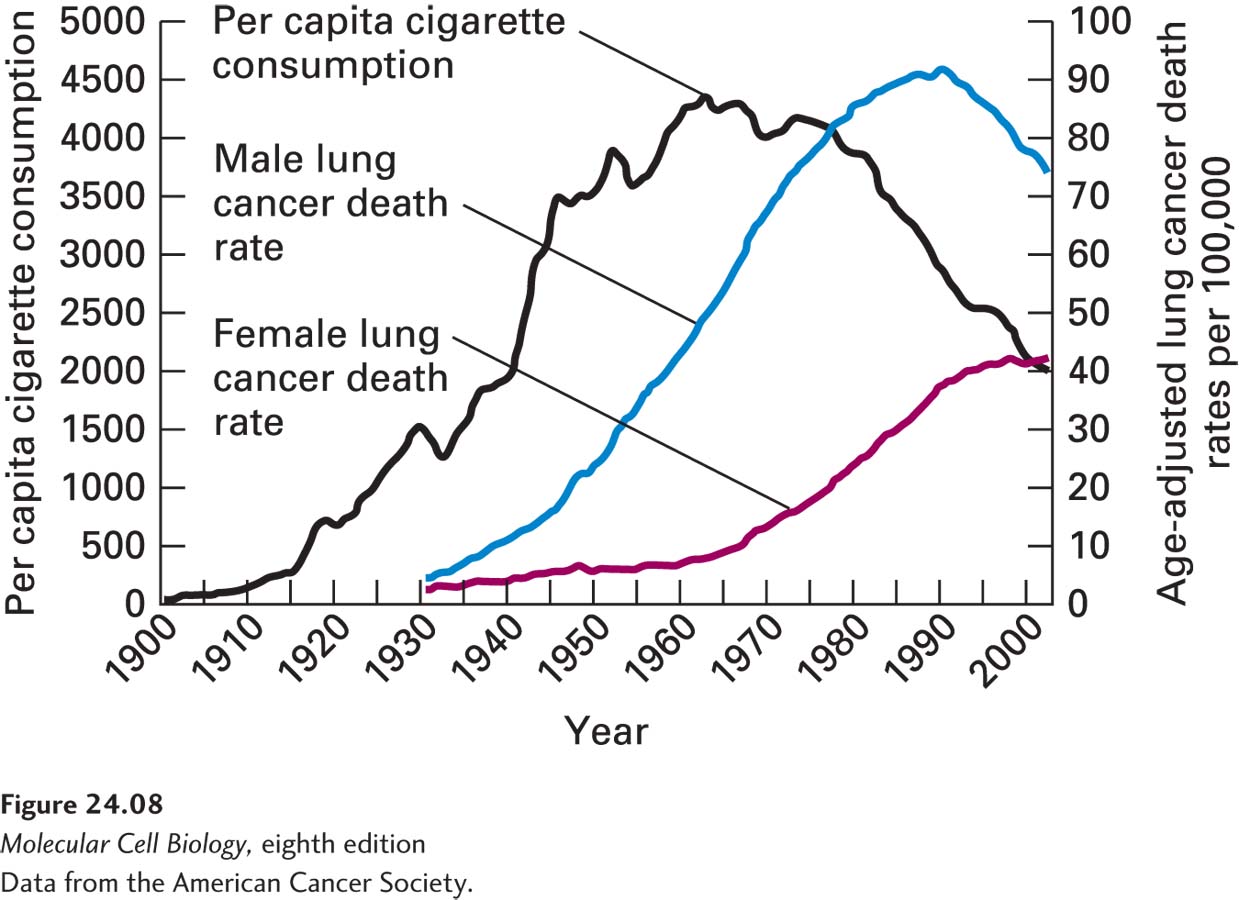Some Carcinogens Have Been Linked to Specific Cancers
In the earliest days of cancer awareness, it became clear that at least some cancers are due to environmental poisons. In 1775, for example, it was reported that the exposure of chimney sweeps to soot caused scrotal cancer, and in 1791, the use of snuff (tobacco) was reported to be associated with nasal cancer. Environmental chemicals were originally associated with cancer through experimental studies in animals. The classic experiment is to repeatedly paint a test substance on the back of a mouse and look for development of local or systemic tumors in the animal. Such assays led to the purification of a pure chemical carcinogen, benzo(a)pyrene, from coal tar in 1933.
The role of radiation in damaging chromosomes was first demonstrated in the 1920s using γ-irradiated Drosophila. Later the ability of radiation to cause human cancers, especially leukemia, was dramatically shown by the increased rates of leukemia among survivors of the atomic bombs dropped in World War II (ionizing radiation) and more recently by the increase in melanoma (skin cancer) in individuals exposed to too much sunlight (ultraviolet radiation).
Although chemical carcinogens are believed to be risk factors for many human cancers, a direct link to specific cancers has been established in only a few cases, the most important being lung cancer and the other cancers (of the larynx, pharynx, stomach, liver, pancreas, bladder, cervix, and more) that are associated with smoking. Epidemiological studies (Figure 24-8) first indicated that cigarette smoking was the major cause of lung cancer, but the reason was unclear until the discovery that about 60 percent of human lung cancers contain inactivating mutations in the p53 gene, which, as we will soon see, is a major tumor-suppressor gene. The chemical benzo(a)pyrene, found in cigarette smoke as well as in coal tar, undergoes metabolic activation in the lungs (Figure 24-9) to form a potent mutagen that mainly causes conversion of guanine (G) to thymine (T) bases, a transversion mutation. When applied to cultured bronchial epithelial cells, activated benzo(a)pyrene induces many mutations, including inactivating mutations at codons 175, 248, and 273 of the p53 gene. These same positions, all within the protein’s DNA-binding domain, are major mutational hot spots in human lung cancer. In fact, the nature of the mutations in p53 (and other cancer-related genes) found in tumor cells gives us clues as to the origin of the cancer. The G-to-T transversions caused by benzo(a)pyrene, for example, are present in the p53 genes of about one-third of smokers’ lung tumors. That type of mutation is relatively rare among the p53 mutations found in other types of tumors. The carcinogen leaves its footprint. Thus there is a strong correlation between one defined chemical carcinogen in cigarette smoke and human cancer. It is likely that other chemicals in cigarette smoke induce mutations in other genes, since it contains more than 60 carcinogens.

FIGURE 24-8 Chemical carcinogenesis by tobacco smoke. Cigarette smoking provides a clear example of a deadly form of chemical carcinogenesis. The rates of lung cancer follow the rates of smoking, with about a 30-year lag. Women began to smoke in large numbers starting in the 1960s, and starting in the 1990s, lung cancer passed breast cancer as the leading cause of women’s cancer deaths. At the same time, a gradual decrease in smoking rates among men starting in the 1960s has been reflected in a decrease in their lung cancer rate.
[Data from the American Cancer Society.]

FIGURE 24-9 Enzymatic processing of benzo(a)pyrene to a more potent mutagen and carcinogen. Liver enzymes, particularly P-450 enzymes, modify benzo(a)pyrene in a series of reactions, producing 7,8-diol-9,10-epoxide, a highly potent mutagenic species that reacts with DNA primarily at the N2 atom of a guanine base. The resulting adduct, (+)-trans-anti-B(a)P-N2-dG, causes polymerase to insert an A rather than a C opposite the modified G base. Next time the DNA is replicated, a T will be inserted opposite the A, and the mutation will be complete. Horizontal arrows indicate alterations toward greater potency, while vertical arrows indicate changes in the direction of reduced toxicity. The large “O” symbol represents the rest of the multi-ring structure shown in the complete benzo(a)pyrene molecule at the left.
Lung cancer is not the only major human cancer for which a clear-cut risk factor has been identified. Asbestos exposure is linked to mesothelioma, another type of lung cancer. Aflatoxin, a fungal metabolite found in moldy grains, induces liver cancer. Furthermore, cooking meat at high temperatures causes chemical reactions that form heterocyclic amines (HCAs), potent mutagens that cause colon and breast carcinomas in animal models. Hard evidence concerning dietary and environmental risk factors that would help us avoid other common cancers (e.g., breast, colon, and prostate cancer and leukemias) is, however, generally lacking.

